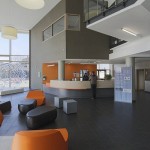Flowers Laboratory
FLOWing Epigenetic Robots and Systems
Acroban
The Acroban Humanoid Project
News: A description of Acroban is now available in the two following articles:
Ly, O., Lapeyre, M., Oudeyer, P-Y. (2011) Bio-inspired vertebral column, compliance and semi-passive dynamics in a lightweight robot, in Proceedings of IEEE/RSJ International Conference on Intelligent Robots and Systems (IROS 2011), San Francisco, US.
Oudeyer, P-Y., Ly, O., Rouanet, P. (2011) Exploring robust, intuitive and emergent physical human-robot interaction with the humanoid Acroban, to appear in the Proceedings of IEEE-RAS International Conference on Humanoid Robots, Bled, Slovenia.
Acroban results from a collaboration between INRIA and University of Bordeaux I/Labri.
Press Release: http://flowers.inria.fr/AcrobanPressRelease.pdf
Communiqué de presse: http://flowers.inria.fr/CommuniquePresseAcroban.pdf
INNOROBO: http://www.innorobo.com/
Photos free of copyreight/Photos libres de droit pour illustrations:http://flowers.inria.fr/pressReleasePhotos.zip
(These photos were taken by a member of the team: Paul Fudal)
The robot
Acroban is a lightweight compliant humanoid robot capable of robust semi-passive dynamic locomotion, life-like movements, and offers the possibility of a new kind of playful physical human-robot interaction. We developped this platform to explore how morphological constraints can simplify the developmental acquisition of complex sensorimotor skills, as well as to explore novel kinds of human-robot interaction.
All Videos on this web site are also available on our Inria FLOWERS Youtube Channel.
Bio-inspired
Bio-inspired, its properties rely heavily on the use of adequate morphology and materials. The use of a multi-articulated vertebral column and compliance (both thanks to its actuators which compliance can be controlled dynamically and to the use of elastics and springs), follows directly the morphology of animals, and bipeds in particular. Coupled with adequate basic modular motor primitives, this provides natural robustness to unpredicted perturbations. It also provides energy efficiency, by allowing to convert potential energy into kinetic energy in a semi-passive way.
Morphological Computation
Dynamic walking, stabilization in the face of unknown perturbations, as well as human-robot interaction capabilities such as described below, are all based on the use of simple sensorimotor primitives/feedback loops with no models of the dynamics/physics of the whole system. Indeed, high-level control leverages the self-organizing properties of physics: the dynamical system induced by the interaction of gravity, inertia and the morphological structure of the robot generates itself stable organized movements.This is what is sometimes referred as morphological computation. High-level centralized control thus mainly consists in tuning those low-level dynamical systems through low-frequency feedback loops (much as in human motor control where the sensorimotor loop between end-effectors/sensors and the central nervous system is typically over 100 ms).
Motor learning considerably simplified by morphological computation
Interestingly, those dynamical systems can be driven through the tuning of a very small number of parameters. For example, it is possible to control the direction and the speed of Acroban dynamic walking only with two parameters controlling a dynamical central pattern generator. This is in sharp contrast with the fact that Acroban as 30 degrees of freedom, all of which charaterized by several dimensions (position, speed, acceleration, stiffness, …): The sensorimotor space in which Acroban produces movement contains indeed several hundred dimensions. This drastic reduction of dimensionality provided by adequate motor primitives, and self-organization properties arising from the coupling of these primitives with the physics of the robot, transforms the computationally apparently very difficult problem of learning locomotion into a much simpler problem. Thus, morphological constraints / computation can facilitate enormously the acquisition of complex full-body motor skills. This is one the central scientific question we are investigating in the FLOWERS team around the AcrobanProject.
Low cost
Interestingly, the motors (Robotis RX-28 and RX-64 series), materials (aluminium and standard springs and elastics), and electronics (standard ARM embedded controller) of Acroban are all low-cost. This allows us to show that it is actually possible to build such robust compliant motor skills and generate original life-like movements with basic affordable components if they are adequately chosen, combined and controlled.
A new kind of interface: Physical human-robot interaction
In Acroban, joints become a tangible interface. Physical interaction is made possible by the ability of the human to modify the state (joint position) of the robot by a direct physical manipulation, thanks to compliance. In this way, joints become the interface between the robot and the human: They make possible the exchange of analogical information. Coupled with morphological computation, this makes it possible to seemlessly drive Acroban by the hand, like a little child, as described below.
The Luxo Jr. Effect
Furthermore, Acroban provokes spontaneous highly positive emotional reactions, especially in children. Yet, as opposed to many other robots, its morphology is neither roundish nor cute. He has no big eyes. He is just made of metal, and its appearance shows it explicitly. At first glance, its visual appearance creates low expectation of intelligence and life-likeness. But when it begins to move and one can touch it, its natural dynamics, much more life-like than most other robots, triggers a high contrast and positive surprise. Life unexpectedly appears out of a neutral metallic object, much asPixar’s Luxo Jr. This is the Luxo Jr. effect.
Team
Olivier Ly – main designer – and Pierre-Yves Oudeyer (researchers), Matthieu Lapeyre (PhD student), Jérome Béchu and Blaise Solé-Blanco (engineers), as well as numerous input from the members of the Rho-Ban project group.
Contact: ly at_ labri.fr and pierre-yves dot oudeyer at_ inria.fr
Publications
Ly, O., Lapeyre, M., Oudeyer, P-Y. (2011) Bio-inspired vertebral column, compliance and semi-passive dynamics in a lightweight robot, in Proceedings of IEEE/RSJ International Conference on Intelligent Robots and Systems (IROS 2011), San Francisco, US.
Oudeyer, P-Y., Ly, O., Rouanet, P. (2011) Exploring robust, intuitive and emergent physical human-robot interaction with the humanoid Acroban, to appear in the Proceedings of IEEE-RAS International Conference on Humanoid Robots, Bled, Slovenia.
Ly, O., Lapeyre, M., Oudeyer, P-Y. (2010) The Humanoid Robot Acroban: Leveraging Semi-Passive Dynamics in the Vertebral Column, INRIA Technical Report. (soon online)
Ly, O., Oudeyer, P-Y. (2010) Acroban the Humanoid: Playful and Compliant Physical Child-Robot Interaction, in ACM SIGGRAPH’2010 Emerging Technologies.
Videos
Video 1: Mechanical structure
This video shows the 30 DOFs mechanical structure of Acroban, showing in particular its multi-articulated torso with the vertebral column as well as springs and elastics.
Video 2: Dynamically Controlled Compliance
This video shows controlled compliance in the torso as well as in the arms and the ankle, illustrating how motors can be tuned dynamically to simulate virtual springs or even free links that can be easily manipulated with a human hand. The mechatronic of Acroban allows real-time adjustment of maximal torque enforced by the joints, which makes it close to force control. This allows in particular making joints compliant by dynamically adjusting their level of resistance to external perturbations. The mechanical structure itself is also compliant: Acroban structure includes springs and elastics (as energy accumulators), which, together with the backlash of servomotors, make it flexible and thus compliant;
Video 3: Intrinsic Structural Compliance
This video demonstrates the structural intrinsic compliance of Acroban due to the combination of backlash, springs and elastics. We see that even when all motors are tuned to be maximally stiff, a significant whole body deformation can happen under external perturbations.
Video 4: Robustness to Unknown External Perturbations
This video illustrates the ability of Acroban to keep its balance under various unknown and large external perturbations, all with a single motor primitive with the same parameters, leveraging
semi-passivity in the whole body, and in the vertebral column in particular.
Video 5: Illustrating Passive Dynamic Walking
This video demonstrates that a particular family of external perturbations, i.e. periodic lateral perturbations here generated by a human, provokes spontaneously passive dynamic walking. While the robot uses the same self-stabilizing motor primitive as in Video 4, this external perturbation, amplified and at the same time stabilized by the active triple pendulum in the multi-articulated torso, makes it realize dynamic steps forward as a consequence of the intrinsic elasticity of the feet and legs.
Video 6: Robust Semi-Passive Dynamic Walking
This video shows that the Acroban humanoid can achieve autonomous semi-passive dynamic walking by generating a self-perturbation in the form of CPGs (central pattern generators), while continuing to keep its balance with the same motor primitive as Video 4, of which motor commands simply add up with those of the CPGs (and these two sets of closed-loop motor primitives interact only through the physics of the robot, which illustrates the modularity of the system). The multi-articulated torso allows both for natural stabilization and accumulation/release of potential/kinetic energy through the coupled triple pendulum system: vertebral column (one inverted pendulum) and arms (two pendulums). This video also demonstrates that the robot is also robust to potentially large unknown external perturbations while dynamically walking.
Video 7: Guiding Acroban with a Joystick through analog control
The CPGs self-perturbing the robot in Video 6 constitute a complex dynamical system in which one is nevertheless able to extract only two control parameters relative to parameterized step splines (see text of the technical report) that allow to drive the robot forward, left and right in a continuous manner. This is shown on the video through analog joystick control.
Video 8: Guide Acroban by the Hand: Intuitive Physical Human-Robot Interaction with Morphological Computation
This video shows that Acroban affords natural intuitive human physical guidance through a physical human robot interface based on morphological computation. When a human takes the arms of the robot with exactly the same motor primitives than those used in Videos 6 and 7, tuned such that the robot alone does not walk forward by itself, then the forces applied to the robot (even weak) by the human make it spontaneously follow the human guidance. There is not a single line of code in the system that tells the robot to follow the human if taken by the hand. This is a spontaneous consequence of the interaction between gravity, inertia and the morphological structure of the robot, an example of what is called morphological computation.
Video 9: Playful Physical Child-Robot Interaction and the Luxo Jr. Effect
This video demonstrates that Acroban affords original physical human-robot interactions where
joints become interfaces and compliance provides safety and intuitiveness. Acroban provokes spontaneous highly positive emotional reactions, especially in children. Yet, as opposed to many other robots, its morphology is neither roundish nor cute. He has no big eyes. He is just made of metal, and its appearance shows it explicitly. At first glance, its visual appearance creates low
expectation of intelligence and life-likeness. But when it begins to move and one can touch it, its natural dynamics, much more life-like than most other robots, triggers a high contrast and positive surprise. Life unexpectedly appears out of a neutral metallic object, much as Pixar’s Luxo Jr. This is why we call it the Luxo Jr. effect.
Photos
More photos are available on request.
Press
Web
Presentation of Siggraph 2010 Emerging Technologies featuring Acroban:
Preston Smith is the SIGGRAPH 2010 emerging technologies chair from the Laureate for Brain Research.
“This does look like a robot we have seen in the past, in that it is a typical structure of a robot, except that this one is actually utilizing true human body type movements with a spine and hip joint movement. It’s actually able to correct itself instead of toppling over as the past robots have done. This one actually has true movements almost like a developing child.”
SIGGRAPH 2010 Emerging Technologies Range from Robotics to Human Taste Simulations
Acroban in Siggraph Emerging Technologies trailer
Engadget: “We see a lot of robots around here. But few can evoke emotion without resorting to a doe-eyed visage or plush, Dough-Boy bodice. That’s what makes Acroban so interesting. Dispensing with the cheap parlor tricks, Acroban still comes across as child-like, playful, seemingly dependent upon your care and guidance.”
Plastic Pals: “Acroban is an exciting example of what is possible using commonly available parts and a lot of ingenuity […] Uncommon among most humanoid robots, its spine has 5 joints alone, as well as springs and elastics, which help to dampen the effects of unexpected external bumps and knocks […] It successfully shrugs off bumps from a ball thrown at its upper body that would turf most of the RoboCup Humanoid league.“
Trossen Robotics blog: Acroban Humanoid Robot Project: “The video demonstrates […] very well, bringing a rather mechanical and utilitarian looking robot to life. Inria Flowers calls this the ‘Luxo Jr. Effect’ named after the pint size companion of Pixar’s lovable Desk Lamp mascot. It really is true though; something about the way this robot moves reaches out to our primal emotional response, making our brain think it’s something actually alive. In doing this, the robot effectively leaps over Uncanny Valley by coming across as very human-like without the increasingly creepy aesthetics that many humanoids fall victim to”.
Wired Gadget Lab: “The Acroban robot is no Marvin, the Paranoid Android. Instead, Acroban promises a sunny personality that’s just right for kids. […]. The most interesting part of the robot is how well it reacts to situations that would seem almost normal in a human context. For instance, when the robot is walking, a person can hold the robot arm and drive it in any direction easily. It’s like steering children who are just learning to walk, says the researchers. All of this is done without providing the robot with any sort of verbal command.“
Acroban on Euronews (English: Meet the robots) (Spanish: Nuevos avances en robotica) (Italian: Le ultime inventioni della robotica) (German: Neues aus der Roboterforschung) (Français: Des robots de plus en plus humanoïdes)
Robotic eyes that can see and interact
Los Angeles Conference Showcases Star Robots
Techfemina.com: Acroban robot wants a childlike affection
Emerging from SIGGRAPH’s Emerging Technology
Associated Press: “The SIGGRAPH Conference and Exhibition in Los Angeles is currently showcasing … Acroban the tiny robot made to move and interact with children.
Acroban: El ligero robot humanoide
Acroban a la moda: Vea el robot con chullo
Acroban: El pequeño humanoide que mantiene el equilibrio como humanos
Proyecto Acroban para un humanoide bio-inspirado
Acroban Robot Will Win Your Heart
Acroban, un humanoide que demuestra lo que es el equilibrio
Robots interactivos: “parece que Acroban Humanoid es por ahora el androide mejor diseñado para interaccionar y jugar con niños y mantener en todo momento el equilibrio sobre sus dos pies -y no caerse a pesar de tropiezos, obstáculo o empujones-.”



